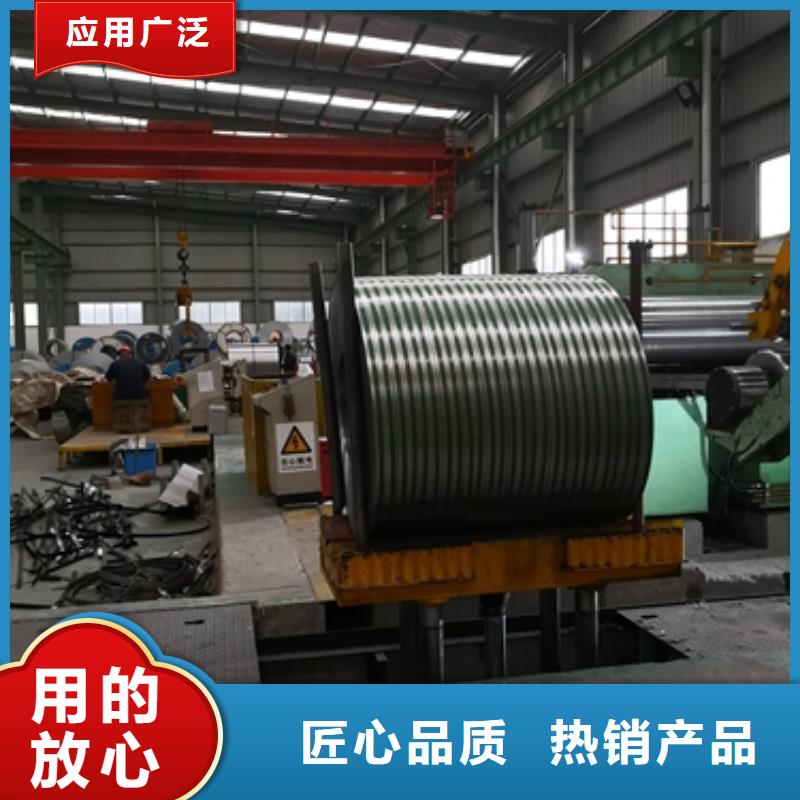我们的现场实拍视频将带您走进35WW270系数电工钢产品的世界,产品视频细节之美一览无余!
以下是:35WW270系数电工钢的图文介绍

电工钢硅钢片对电工钢板性能的要求如下:铁芯损耗(PT)低铁芯损耗是指铁芯在≥50Hz交变磁场下磁化时所消耗的无效电能,简称铁损,也称交变损耗,其单位为W/kg。这种由于磁通变化受到各种阻碍而消耗的无效电能,通过铁芯发热既损失掉电能,又引起电机和变压器的温升。电工钢的铁损(PT)包括磁滞损耗、当地涡流损耗(Pe)和反常损耗(Pa)三部分。电工钢板铁损低,既可节省大量电能,又可延长电机和变压器工作运转时间,并简化冷却装置。由于电工钢板的铁损所造成的电量损失占各国全年发电量的2.5%~4.5%,因此各国生产电工钢板总是千方百计设法降低铁损,并以铁损作为考核产品磁性的重要指标,按产品的铁损值作为划分产品牌号的依据。冷轧取向电工钢:冷轧取向电工钢是电工钢中的高端产品,与冷轧无取向电工钢相比,磁性具有强烈的方向性;在易磁化的轧制方向上具有优越的高磁导率与低损耗特性。取向钢带在轧制方向的铁损仅为横向的1/3,磁导率之比为6:1。用途:冷轧取向硅钢带主要的用途是用于变压器制造。


电工钢硅钢片本文件规定了公称厚度为 0.18mm、本地0.20mm、本地0.23mm、本地0.27mm、本地0.30mm 和 0.35mm 全工艺冷轧取向电工钢带的定义、本地分类和代号、本地尺寸、本地外形、本地重量、本地磁性能、本地检验和试验、本地包装、本地标志及质量证明书等要求。本文件适用于宝山钢铁股份有限公司生产的以终退火状态交货的全工艺冷轧取向电工钢带(以下简称产品)。2 规范性引用文件下列文件中的内容通过文中的规范性引用而构成本文件必不可少的条款。其中,注日期的引用文件,仅该日期对应的版本适用于本文件;不注日期的引用文件,其 版本(包括所有的修改单)适用于本文件。GB/T 228.1 金属材料拉伸试验 部分:室温实验法GB/T 247 钢板和钢带包装、本地标志及质量证明书的一般规定GB/T 2521.2 全工艺冷轧电工钢 第 2 部分:晶粒取向钢带(片)GB/T 2522 电工钢片(带)表面绝缘电阻、本地涂层附着性测试方法GB/T 2900.60 电工术语 电磁学GB/T 3655 用爱泼斯坦方圈测量电工钢片(带)磁性能的方法GB/T 4340.1 金属材料维氏硬度试验 部分:试验方法GB/T 8170 数值修约规则与极限数值的表示和判定GB/T 9637 电工术语磁性 材料与元件GB/T 13789 用单片测试仪测量电工钢片(带)磁性能测量方法GB/T 17505 钢及钢产品 交货一般技术要求GB/T 18253 钢及钢产品检验文件的类型GB/T 19289 电工钢片(带)的密度、本地电阻率和叠装系数的测量方法YB/T 4292 电工钢带(片)几何特性测试方法Q/BQB 400 冷轧产品的包装、本地标志及检验文件IEC 60404-8-7Magnetic materialsSpecifications for individual materials – Cold-rolled grain-orientedelectrical steel strip and sheet delivered in the fully-processed stateIEC/TR 62581-2010 Methods of measurement of the magnetostriction characteristics by meansof single sheet and Epstein test specimens3 术语和定义GB/T 2521.2、本地GB/T 2900.60、本地GB/T 9637 和 YB/T 4292 界定的以及下列术语适用于本文件。



鹿程国际贸易(西藏分公司)位于宝山区蕰川公路777号宝钢厂区607-609室,公司具有现代化的生产设备和多年的生产技术,产品的多样化即美观大方又有j i好的立体效应,自动化表面浸塑,使产品具有了耐腐蚀、抗老化 、耐酸碱、不腿色、表面平整、光亮、手感好的特点,进而使产品达到完美的境界。
我公司生产的产品主要包括: 冲压用钢等产品,公司成立迄今,正是由于各界朋友们对于我们的持续支持与关怀,及本公司全体同仁辛勤的耕耘与付出,使公司持续发展与茁壮成长。展望未来,我公司怀着感恩之心,更加追求卓越的业绩,来回馈社会,服务顾客。



电工钢硅钢片In addition to the types listed above, there are also some special purpose electrical steel plates, such as 0.15 and 0.20mm thick 3% Si cold-rolled non oriented silicon steel strips and 0.025, 0.05, and 0.1mm thick 3% Si cold-rolled oriented silicon steel strips, used for medium and high-frequency motors, transformers, and pulse transformers; 0.7mm thick 3% Si high-strength cold-rolled non oriented silicon steel plate for relays and power switches; High strength cold-rolled electrical steel plate for new high-speed motor rotors; Low carbon electrical steel hot-rolled thick and cold-rolled plates for magnetic shielding and high-energy accelerator electromagnets such as medical magnetic resonance tomography scanners; 4.5% to 6.5% Si high silicon steel plates for high-frequency motors, transformers, and magnetic shielding.Generally, motors, transformers, and other electrical components are required to have high efficiency, low power consumption, small size, and light weight. Electrical steel plates are usually guaranteed to have magnetic properties based on core loss and magnetic induction strength [1] [2]. The requirements for the performance of electrical steel plates are as follows:Low core loss (PT)Iron core loss refers to the ineffective electrical energy consumed by an iron core when magnetized in an alternating magnetic field of ≥ 50Hz, abbreviated as iron loss, also known as alternating loss, and its unit is W/kg. The ineffective electrical energy consumed due to various obstacles caused by magnetic flux changes not only loses electrical energy through the heating of the iron core, but also causes temperature rise of the motor and transformer. The iron loss (PT) of electrical steel includes three parts: hysteresis loss, eddy current loss (Pe), and anomalous loss (Pa). Electrical steel plates have low iron loss, which can save a lot of electricity, prolong the operating time of motors and transformers, and simplify cooling devices. Due to the iron loss of electrical steel plates, which accounts for 2.5% to 4.5% of the annual electricity generation in various countries, countries always try their best to reduce iron loss in the production of electrical steel plates, and use iron loss as the most important indicator to assess the magnetic properties of products. The iron loss value of products is used as the basis for classifying product grades. Cold rolled oriented electrical steel: Cold rolled oriented electrical steel is a high-end product in the field of electrical steel. Compared with cold rolled non oriented electrical steel, its magnetism has strong directionality; It has superior high magnetic permeability and low loss characteristics in the direction of easy magnetization rolling. The iron loss of oriented steel strip in the rolling direction is only 1/3 of that in the transverse direction, and the ratio of magnetic permeability is 6:1. Application: The main purpose of cold-rolled oriented silicon steel strip is for transformer manufacturing.Full process cold rolled non oriented silicon steel coating: The surface of the full process cold rolled silicon steel is coated with a semi transparent insulation coating, which has different codes in different standards. Taking Baosteel‘s Q/BQB 480 2014 as an example:



 08qx.com
08qx.com






